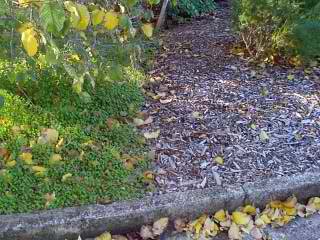Torrens Park Railway Station Project
A small but significant activity of the The Australian Plants Society (SA Region) has been the revegetation of the Torrens Park suburban railway station, in the Adelaide foothills.
The project commenced in 1992, after the original station buildings had been replaced, and adjacent areas landscaped. The initial plantings have been progressively added to at approximately six-monthly intervals ever since. The criteria for the project have been as follows:-
- Only about 20 plants are put in at each occasion. Since they all have to be hand-watered, this is a number which easily can be coped with.
- They are watered for six months, after which they are on their own.
 |
| The difference between the weed-cleared and mulched project area (right) and annual soursob growth on adjacent private land (left) |
There are lessons to be learned from the exercise. First is the value of effective weed control. Our strategy has been to hand pull all the weeds, and to heavily mulch the area to prevent regeneration. Even so, weed control is an on-going but annually diminishing exercise.
Secondly, at the end of their six months' watering, some plants promptly resign, while others hang on for a couple of years before giving up the unequal struggle. Such casualties are attributable mainly to the planting of inappropriate species that were not able to cope with the prevailing conditions of heat; on a steep, mainly west-facing slope; inappropriate aspect; poor soil; and so forth. What remains is a measure of more successful selection, at least some of which has been based on trial and error.
Thirdly, after some of the initial losses, we opted for planting some primary colonisers (fast-growing short-lived species that provide much-needed cover for the slower growing plants during their more vulnerable early stages of development). This has resulted in a somewhat lop-sided and unbalanced appearance, but the survival rate now is much better than it was.
Finally has been the recognition that, human nature being what it is, it is important to try and anticipate what people may do, and to minimise their potential negative impact. Deliberate vandalism has been minimal, but plant stakes are a magnetic attraction, so we aimed to have them as small and unobtrusive as possible, but still big enough to warn the inadvertent trampler - and to replace those that have gone missing.
 |
| One of the smaller revegetated sections of the project |
An entirely unanticipated difficulty has been from the activities of blackbirds. They are forever scratching at the mulch, and on a steep slope gravity dictates all movement is downhill, so bare surfaces developed at the top, and mulch grew to half a metre deep at the base. Our solution has been to 'contour' the slope with old railway sleepers. They do not, of course, prevent the problem, but they minimise the impact.
Ultimately, the project has been a success, due to:
- The Australian Plants Society for propagating most of the plants
- Mitcham City Council for supplying as much mulch as we needed
- TransAdelaide for supplying the water point (and water), as well as sleepers, and particularly for allowing us to go ahead with the project on what is, after all, their land
- Many hours of toil by all who have assisted, particularly Tony Hill, past president of the SA Region, who is a specialist in shrubs and other low-growing species.
Our success can be measured in two ways; firstly, the project was a finalist in the1997 KESAB Action Awards. Secondly, although it is little more than a railway embankment 100 metres long, and it may look aesthetically pleasing to us, it nevertheless has brought back to the suburbs bird species that once were common in the area, but which now are rarely seen. Watching an eastern spinebill carefully picking its way through the Grevillea blossom is a pleasant way to while away the time waiting for the train.
Search:



